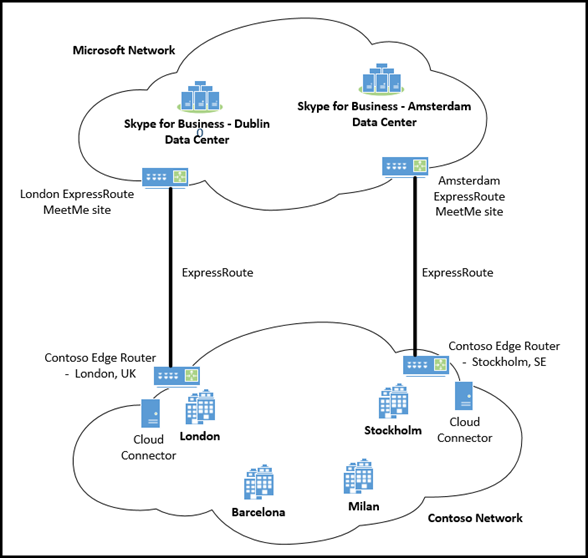Media Quality and Network Connectivity Performance in Microsoft Teams
Important
Skype for Business Online operated by 21Vianet in China will be retired on October 1, 2023. If you haven't upgraded your Skype for Business Online users yet, they will be automatically scheduled for an assisted upgrade. If you want to upgrade your organization to Teams yourself, we strongly recommend that you begin planning your upgrade path today. Remember that a successful upgrade aligns technical and user readiness, so be sure to leverage our upgrade guidance as you navigate your journey to Teams.
Skype for Business Online, excluding the service operated by 21Vianet in China, was retired on July 31, 2021.
This article defines the set of network performance requirements for Microsoft Teams services and how you can choose to use the Internet or ExpressRoute for connectivity between your network and Microsoft Teams based your assessment of the network connectivity. If you have decided to deploy Azure ExpressRoute for dedicated connectivity to Microsoft 365 or Office 365, this document also provides guidance on how to plan your ExpressRoute connections in different Microsoft Teams deployment scenarios.
The quality of Real-Time media (audio, video, and application sharing) over IP is greatly impacted by the quality of end-to-end network connectivity. For optimal Microsoft Teams media quality, it is important for you to make sure there is a high-quality connection between your company network and Microsoft Teams. The best way to accomplish this is to set up your internal network and cloud connectivity based on the capacity of your network to accommodate for peak traffic volume for Microsoft Teams across all connections.
Azure ExpressRoute isn't a requirement for Microsoft 365 and Office 365 services including Microsoft Teams. However, Azure ExpressRoute is one of the deployment options that are available that will help make sure that connectivity to Microsoft 365 or Office 365 meets the Microsoft Teams network performance requirements and ensures the most optimal Microsoft Teams media quality experience.
Tip
Although this topic provides you with overall networking performance guidance, complete guidance for network assessment is outside of the scope of this document. To find a list of Microsoft Teams partners who can help you with the network performance measurements as part of a thorough and complete network assessment, please visit Skype for Business Partner Solutions.
Network connectivity requirements to Microsoft Teams
Factors that impact Microsoft Teams media quality
There are many different factors that contribute to Microsoft Teams Real-Time media (audio, video, and application sharing) quality that includes the devices that are used, the environment, and the network connectivity.
Devices
In a Real-Time media session, media capturing and rendering devices that are used by all participants such as headsets and Web cams have a great impact on the overall audio and video quality. Lower quality devices or devices with incorrect device drivers produce lower overall sound quality for audio and lower image quality for video. Certified devices or good quality devices help with echo cancellation, noise filtering, video resolution and reduce latency.
Although certified audio and video media devices aren't required, it's highly recommended devices certified for Microsoft Teams for the most optimal media experience. For a list of all Microsoft Teams certified devices, see Microsoft Teams certified Android devices. You can use the Microsoft Teams Call Quality Dashboard, found in the Skype for Business admin center, to verify devices in use are working correctly and monitor audio and video media quality.
Tip
A certified device is required for the most optimal Skype for Business media quality experience.
It's important to remember that any media devices, Microsoft Teams clients, and Skype for Business Servers through which Real-Time media flows, introduce some amount of latency. The device and software processing latency, along with network latency, have a great impact on and contribute to the end-to-end overall latency and the end user's experience.
Environment
The environment and surrounding area where users are meeting and using audio and video devices is another large factor for audio and video quality. Users calling from a noisy environment will have echoed, muffled, and unclear audio. Users in a dark or low light environment won't be able to produce bright, clear image quality for video. In a conference room setting, the location of the microphone and video device have a direct impact on the sound and image quality that participants receive.
To get a clearer picture of a user's audio and video experience use the Skype for Business app Tools > Options > Audio Device or Video Device to make changes to the device in use and customize its settings.
Network
The quality of the Real-Time media over IP network is greatly impacted by the quality of the network connectivity, but especially by the amount of:
Latency This is the time it takes to get an IP packet from point A to point B on the network. This network propagation delay is tied to physical distance between the two points and the speed of light, including extra overhead taken by the various routers in between. Latency is measured as one-way or Round-trip Time (RTT).
Packet Loss This is often defined as a percentage of packets that are lost in a given window of time. Packet loss directly affects audio quality—from small, individual lost packets having almost no impact, to back-to-back burst losses that cause complete audio cut-out.
Inter-packet arrival jitter or simply jitter This is the average change in delay between successive packets. Most modern VoIP software including Microsoft Teams can adapt to some levels of jitter through buffering. It's only when the jitter exceeds the buffering that a participant notices the effects of jitter.
Note
Buffering for jitter will increase end-to-end latency.
With many concurrent Microsoft Teams Real-Time media sessions, and other network traffic generated by other Microsoft 365 or Office 365 services and other business applications, making sure that there is sufficient bandwidth over the entire network path that connects your network to the Microsoft Teams service is critical to avoid network congestion and ensure excellent media Real-Time media (audio, video, and application sharing) quality.
Implementing Quality of Service (QoS) across congested networks
In addition, traffic congestion across a network greatly impacts media quality. To allow audio and video packets to travel the network quicker and to be prioritized over other network traffic in a congested network, Quality of Service (QoS) can be used to help provide an optimal end-user experience for audio and video communications.
QoS provides a way for you to assign higher priorities to network packets that are carrying audio or video data. By assigning a higher priority to these packets, audio and video communications are likely to travel over the network faster, and with less interruption, than network sessions involving things like file transfers, web browsing, or database backups. That's because the network packets used for file transfers or database backups by default are assigned "best effort" as a priority and network congestion won't have as large impact. If you don't assign a higher priority to the media (audio, video, and application sharing) packets and leave them also assigned as "best effort", they too will be processed along with all other network traffic. Depending on the amount of network congestion, this will potentially end up in a lower overall audio and video quality experience for your users.
It is highly recommended that you implement QoS on your network to make sure that network congestion within your network won't have an impact. However, for this to have the maximum impact, all networking endpoints must support QoS, meaning that all endpoints must honor QoS marking and packet prioritization. Microsoft Teams services honor QoS marking and prioritization within the Microsoft network. However, traffic that is routed across a public connection like the Internet from your company network to the Microsoft network doesn't preserve QoS markings and packet prioritization. Private connections from your network to Microsoft 365 or Office 365 using Azure ExpressRoute offer a deployment solution that preserves QoS markings and packet prioritization that will in turn increase overall audio and video quality for your end users.
Network performance requirements to connect to Microsoft Teams
Skype for Business Real-Time media travels through many different devices, client apps, server software, and across different networks. The end-to-end latency of Real-Time media is the total amount of latency that is introduced across all components and network segments. The quality of the end-to-end network connection is determined by the network segment with the worst quality. This segment acts as a bottleneck for this network traffic.
The following diagram illustrates one-way audio flow in a conference from one Microsoft Teams participant to another.
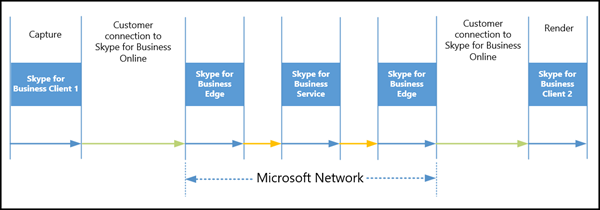
In this conferencing scenario, the media path consists across the following network segments:
Connection from User 1 to the edge of the Microsoft network This usually includes a network connection such as WiFi or Ethernet, the WAN connection from User 1 to the Internet egress point (your network Edge device), and the Internet connection from your network Edge to Microsoft network Edge.
Connection within Microsoft network This is between the Microsoft Edge to Microsoft Teams data center, where the A/V Conferencing servers are used.
Connection within Microsoft Network This is between the Microsoft Teams data center and Microsoft network Edge.
Connection from Microsoft network edge to User 2 This includes the Internet connection from your network Edge to Microsoft network Edge, the WAN connection from User 2 to the Internet egress point (your network Edge), and the network connection such as a WiFi or an Ethernet.
The following diagram shows breakdown of components and network segments of a Microsoft Teams PSTN call:

In a PSTN call scenario, the media path crosses the following network segments:
Connection from a Skype for Business client caller to the edge of the Microsoft Network This usually includes a network connection such as WiFi or Ethernet, the WAN connection from the Skype for Business client caller to the Internet egress point (your network Edge device), and the Internet connection from your network Edge to Microsoft network Edge.
Connection within Microsoft network This is between the Microsoft Edge to Microsoft Teams data center, where a Mediation Server is used.
Connection within Microsoft Network This is between the Microsoft Teams data center and Microsoft network Edge.
Connection between Microsoft Network and the PSTN service provider partners This is the connection that exists to place a PSTN call from the Skype for Business client that is outside of the Microsoft network.
Network Performance requirements from a Skype for Business client to Microsoft network Edge
For optimal Skype for Business media quality, the following network performance metrics targets or thresholds are required for a connection from your company's network to the Microsoft network Edge. This segment of the network includes your internal network, this includes all WiFi and Ethernet connections, any company site-to-site traffic over a WAN connection, for example Multiprotocol Label Switching (MPLS), and the Internet or ExpressRoute partner connections to the Microsoft network Edge.
Caution
Connectivity between a Skype for Business client on your company network to Microsoft 365 or Office 365 services must meet these following network performance requirements and thresholds.
| Metric | Optimal | Poor |
|---|---|---|
| Round Trip Time (RFC 3550) | < 60 ms | > 500 ms |
| Maximum Packet Loss (RFC 3550) | < 5% | > 25% |
| Average Packet Loss (RFC 3550) | < 0.5% | > 10% |
| Packet Jitter (RFC 3550) | < 3 ms | > 30 ms |
Other performance target requirements:
The Microsoft network has over 160 Edge locations worldwide. We work with major Internet Service Providers (ISPs) worldwide through those Edge sites. The latency metric target assumes your company site or sites and the Microsoft Edges are on the same continent.
Your company site or sites to the Microsoft network Edge connection include first hop network access, which can be WiFi or another wireless technology.
The network performance target assumes proper bandwidth and/or quality-of-service planning. In other words, This applies directly to Skype for Business Real-Time media traffic when the network connection is under a peak load.
Measuring network performance
To measure the actual network performance, especially for latency and packet loss, from any company network site to a network Edge, you can use tools such as ping, test against a set of Skype for Business media relay services running from the Microsoft Edge and data center sites.
Note
Measuring network performance through ping (ICMP) is not effective. For that reason, the anycast IP expose below will stop answering to ICMP requests starting in Jan, 2020. To measure network performace effectively, Microsoft recommends the Network Assesment Tool.
For testing Internet connections to the Microsoft network, it is recommended that you test against the following VIPs of the Skype for Business media relays. The Anycast VIP will resolve to an IP address of a Media Relay in a Microsoft network Edge site that is closest to the testing location.
| IP address |
Type |
Location |
|---|---|---|
| 13.107.8.2 |
VIP |
World Wide Anycast IP |
Here are some high level recommendations to follow for assessing network performance:
You should assess your internal network and the connections to Microsoft 365 or Office 365.
You should assess and gather data for all of your networks over a long period of time. We recommend for you to perform your testing of network performance for a minimum of a week, so that you can see usage patterns for all business days and hours. This will show you peak times.
You should take multiple samples of network performance measurements. We recommend taking a measurement every 10 minutes from a company site during the entire period of time you are gathering data. For comparing the Microsoft Teams network performance requirements, take the 90th percentile measurement value from this sample data set.
You should continuously assess the network's performance. Network utilization varies over time due to usage pattern changes, new enterprise-based applications that use a large amount of bandwidth, and changes to your organizational or physical company locations. It is important for you to continuously monitor your network performance against these network performance requirements and targets/thresholds and make timely adjustments to ensure the most optimal Real-Time media quality.
Measuring Network Performance using Azure VMs
Instead of testing against the Microsoft network Edge sites, there are network assessment solutions from Skype for Business customers and partners that use testing setup for services in the Microsoft Azure cloud. In those solutions, the network assessment tools test latency, packet loss and jitter against custom endpoints set up as a service in the Azure cloud. As a result, the test network traffic travels through one other network segment, which is the connection within the Microsoft network between the network edges and Azure data centers that hosts the network assessment service.
For those network assessment solutions based on Azure hosted testing services. We recommend performing the network assessment within country and/or region. For example, for customer sites in east U.S., the assessment should be performed against a testing service instance hosted in Azure's east US data center region.
Below are the latency (RTT) targets for the Azure service-based network assessment setup. The one-way latency targets will be half of the corresponding RTT targets. The packet loss and jitter goals stay the same as those defined for Skype Media Relay based testing.
| Customer region |
Azure region |
Your network Edge - Azure Round-trip Time (RTT) |
Your Site - Azure Round-trip Time (RTT) |
|---|---|---|---|
| Central US |
Central US |
99 |
139 |
| East US |
East US |
86 |
126 |
| North Central US |
North Central US |
97 |
137 |
| South Central US |
South Central US |
94 |
134 |
| West US |
West US |
94 |
134 |
| Hawaii US |
West US |
116 |
156 |
| Canada Central |
Canada Central |
138 |
178 |
| Canada East |
Canada East |
131 |
171 |
| North Europe |
North Europe |
99 |
139 |
| West Europe |
West Europe |
95 |
135 |
| East Asia |
East Asia |
118 |
158 |
| Southeast Asia |
Southeast Asia |
97 |
137 |
| Japan East |
Japan East |
111 |
151 |
| Japan West |
Japan West |
118 |
158 |
| Brazil South |
Brazil South |
70 |
110 |
| Australia East |
Australia East |
124 |
164 |
| Australia Southeast |
Australia Southeast |
124 |
164 |
| Central India |
Central India |
103 |
143 |
| South India |
South India |
103 |
143 |
| West India |
West India |
103 |
143 |
| China East |
China East |
120 |
160 |
| China North |
China North |
120 |
160 |
Media quality and ExpressRoute
Azure ExpressRoute for Microsoft 365 or Office 365 is a dedicated network connection for connecting to Microsoft 365 or Office 365. It offers customers the ability to have control over the path their network traffic takes. They no longer have to be concerned with the unpredictable routing that happens on the Internet where data is carried by unknown carriers, providers, and ISPs. Network traffic that is sent through ExpressRoute is sent directly across the ExpressRoute partner's network to Microsoft's network. This allows customers to treat Microsoft 365 or Office 365 as if it is located in their own off-site data center with a dedicated connection.
Azure ExpressRoute is available for all Microsoft 365 and Office 365 licensing offerings. However, the Azure ExpressRoute Premium Add-on is required for Microsoft 365 and Office 365 to enable global routing. Customers with at least 500 seats who are implementing ExpressRoute can get the required ExpressRoute Premium Add-on at no extra expense.
Is ExpressRoute required for good media quality?
Azure ExpressRoute isn't a requirement for getting the most optimal Microsoft Teams media quality. It is, however, one of the deployment options that help you make sure that your cloud connectivity meets the Skype for Business network performance targets or thresholds.
Microsoft 365 and Office 365 are high performance and secure services that use the Internet. We continue to invest in new security capabilities and regional Edge nodes to continuously improve security and performance. Azure ExpressRoute isn't a requirement for Microsoft 365 or Office 365 services including Microsoft Teams. Azure ExpressRoute is one of the deployment options that are available that help make sure that connectivity to Microsoft 365 or Office 365 meets the Skype for Business network performance requirements and ensures the most optimal Microsoft Teams media quality experience.
For Microsoft Teams media quality, it is important that the connection between your company sites and the Microsoft network Edges meets the performance targets in Network Performance requirements from a Skype for Business client to Microsoft network Edge and that the connection between your network Edges and the Microsoft network edges meets the performance targets.
It is also important that your company's physical network connectivity, including your internal network and cloud connectivity capacity accommodate peak media traffic volume. Azure ExpressRoute is one of many ways that help customers ensure their Microsoft Teams cloud connectivity meets all of these performance requirements.
Is ExpressRoute required for voice quality SLA?
No, ExpressRoute isn't required for Microsoft Teams Voice Quality SLA. The Microsoft Teams Voice Quality SLA applies to any eligible call placed by any Microsoft Teams voice service user within the correct license and subscription that enables that user to make any type of VoIP or PSTN call. A voice quality SLA should include that all of the following conditions are addressed:
Calls from Microsoft certified IP Phones.
Wired Ethernet connections.
Voice quality issues due to Microsoft Network problems.
Note
The voice quality SLA excludes those calls where the low call quality is caused by problems in non-Microsoft networks including ExpressRoute partner and other networks.
Internet or Azure ExpressRoute?
Before making a decision on network connectivity options to Microsoft Teams, customers must assess their network and current Internet connectivity based on the network performance requirements described in Network performance requirements to connect to Microsoft Teams.
If network performance over the current Internet connection is set up for enough capacity during peak time and that it meets the network performance requirements from sites to Microsoft network Edges and from your network Edges to Microsoft network Edges, you can continue to use your existing Internet connectivity to connect to Microsoft Teams.
For company sites where network performance requirements aren't being met, we strongly recommend that you first work with your existing network service providers to improve your overall network performance. However, if they aren't still being met, using Azure ExpressRoute can help ensure your Microsoft Teams cloud connectivity can help you meet the network performance requirements.
Azure ExpressRoute offers the following additional benefits:
A service level agreement (SLA) on availability of the connection between your network and Microsoft network. ExpressRoute has a guaranteed Availability SLA of 99.9%.
Planned and guaranteed bandwidth required for Microsoft 365 and Office 365 services. You can achieve this by sending only Microsoft 365, Office 365, or Skype for Business traffic using the ExpressRoute and then have all other Internet traffic go through other Internet egress/ingress points for your network.
ExpressRoute is designed to preserve DSCP QoS markings between your network and the Microsoft Network.
For more information about ExpressRoute QoS and capacity planning, please refer to ExpressRoute and QoS in Microsoft Teams.
Can I set up Azure ExpressRoute for Microsoft Teams Only?
Yes, you can set up Azure ExpressRoute to ensure excellent network connectivity from your company's network to only Microsoft Teams. This will provide the most optimal Real-Time media quality for your users but you can then continue connecting to other Microsoft 365 or Office 365 services over the Internet.
The Border Gateway Protocol (BGP) is a routing protocol on the Internet that is used to route network traffic across the Internet. It is designed to exchange routing information between autonomous systems (AS) found across the Internet. BGP communities values are attribute tags that can be applied to incoming or outgoing routes. BGP communities are often used to signal to the receiving AS, which outbound link to use to reach a given destination based on geography, service type or other criteria.
With BGP communities support, Microsoft will tag prefixes and routes with appropriate BGP community values based on the service they belong to. Microsoft will tag prefixes advertised through public peering and Microsoft peering with appropriate BGP community values indicating the region the prefixes are hosted in. You can rely on the community values to make appropriate routing decisions to offer optimal routing. You can use the Microsoft Teams BGP community value to set up an ExpressRoute connection only for Microsoft Teams. You can find out more at ExpressRoute routing requirements.
ExpressRoute connectivity scenarios for Microsoft Teams
If you have decided that ExpressRoute based on recommendations above is for you, here are the recommendations on where and how many ExpressRoute connections you should get.
Online only deployment - Single site
If all of your users use the Microsoft Teams service, and if your offices are centered around a single physical location and you decide to deploy Azure ExpressRoute, you should set up single ExpressRoute connection between your company site to the closest ExpressRoute peering location.
The following graphic shows an example of this type of deployment. For this example, Contoso is a university located in Orlando, FL. Contoso has 10,000 faculty members and students. The Internet tests from their location to Microsoft Edge sites showed greater than 5% packet loss during peak class hours. They have decided to get a dedicated connection to Microsoft 365 or Office 365 using ExpressRoute with over-provisioned bandwidth so they can avoid the network congestion for Microsoft 365 or Office 365 especially for Microsoft Teams Real-Time traffic. They connect to the Microsoft cloud through ExpressRoute at the Atlanta, GA MeetMe site.
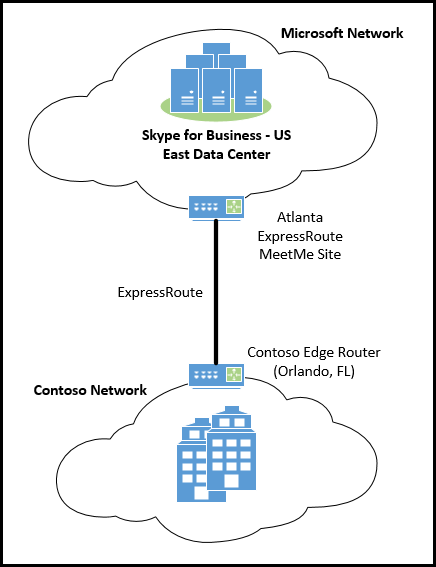
Online only deployment - Multiple sites on the same continent
If your company is using Microsoft Teams services from multiple offices in the same region or continent, and you chose to implement Azure ExpressRoute, it is recommended to connect your main site via ExpressRoute, and then optionally add additional ExpressRoute peering for other locations that do not meet the recommended network performance targets.
In the following example, Contoso is a US travel services company that is headquartered in New York but has other offices across the United States. Their offices are inter-connected through a WAN that uses MPLS for connecting to Microsoft 365 or Office 365. They initially set up an ExpressRoute connection from their Internet router in Hoboken, New Jersey to the New York MeetMe site.
With this setup, network traffic from most of their sites to the Microsoft Network (New York Edge site) can meet the Skype for Business client connection network performance targets described in Network Performance requirements from a Skype for Business client to Microsoft network Edge. However, latency between Contoso's west coast offices to New York is going over 50 ms one way. In addition, Honolulu is the second largest office for Contoso, latency from Honolulu to New York exceeds 80 ms one way. To ensure good media quality for users in those offices, Contoso decided to add a west coast ExpressRoute connection between their San Jose site and the Silicon Valley ExpressRoute MeetMe site.
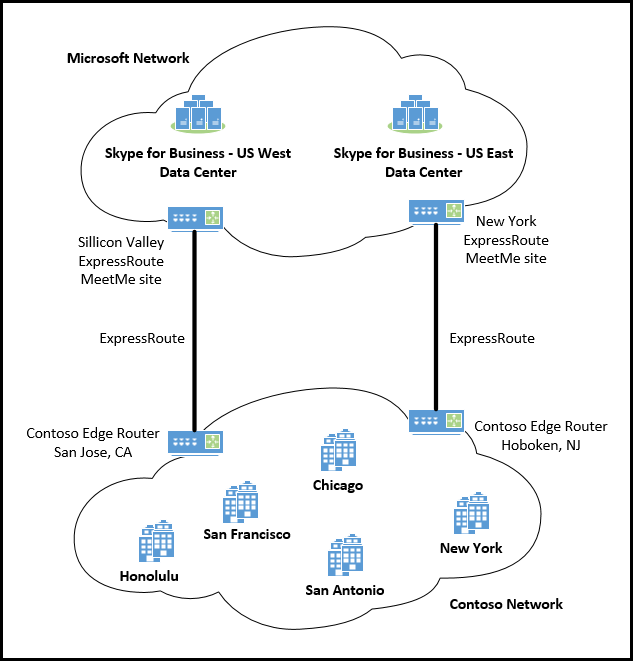
Online only deployment - Multiple sites on different continents
If all of your users are using Microsoft Teams service, and if your offices are in multiple physical locations across multiple continents, if you decide to deploy Azure ExpressRoute, you should set up at least one ExpressRoute connection for each continent between each continent's main site to its closest ExpressRoute peering location. Depending on cost vs benefit, you can choose to deploy additional ExpressRoute connections from sites where network performance targets aren't met.
In the following example, Contoso is a large corporate law firm with offices in major cities across North America and Europe. Based on their Internet connection and their internal network performance assessment, Contoso decided to deploy two ExpressRoute connections in North America and a single ExpressRoute circuit for all their European offices.
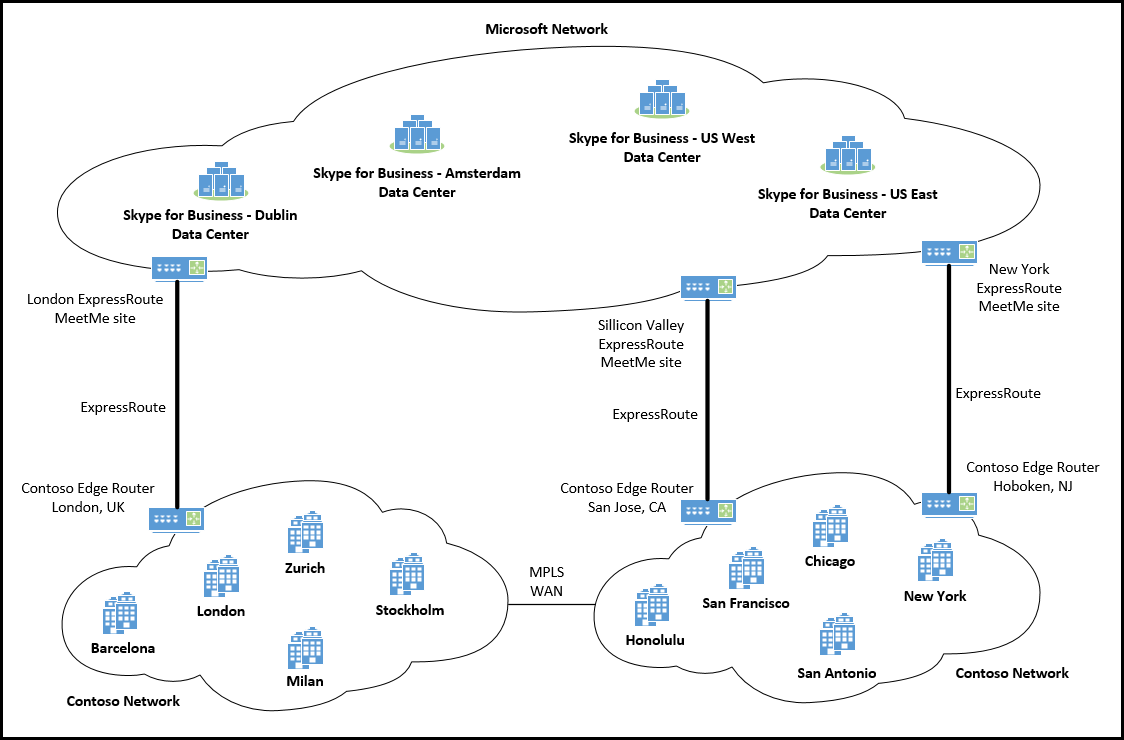
Hybrid deployment
If you have an on-premises Lync or Microsoft Teams deployment and choose to implement a hybrid Microsoft Teams integration, we recommend that if you decide to deploy Azure ExpressRoute, you need to have at least one ExpressRoute connection for each on-premises Lync or Microsoft Teams Edge site and at least one ExpressRoute connection for each continent with offices. Depending on cost vs benefit, for each continent you can choose to deploy additional ExpressRoute connections from offices where network performance targets aren't being met.
If you have an on-premises Microsoft Teams deployment, you must follow the Edge Server Planning and Deployment Guide. Specifically, the Edge servers must be reachable from outside of your network. This is usually achieved either by assigning a routable public IP address to the Edge server, or by using network address translation (NAT).
In the following example, Contoso has an existing on-premises Microsoft Teams Enterprise Voice deployment. They want to migrate on-premises users to Microsoft 365 or Office 365 online services. They also decided to use a hybrid deployment so that they can continue to use their existing PSTN infrastructure for all on-premises and online users. Contoso's on-premises data center and Skype for Business Edge Servers are in Chicago. For their deployment, Contoso decided to set up one ExpressRoute connection between their Chicago data center and the Chicago ExpressRoute. They also added a west coast ExpressRoute connection to better serve their Honolulu office.
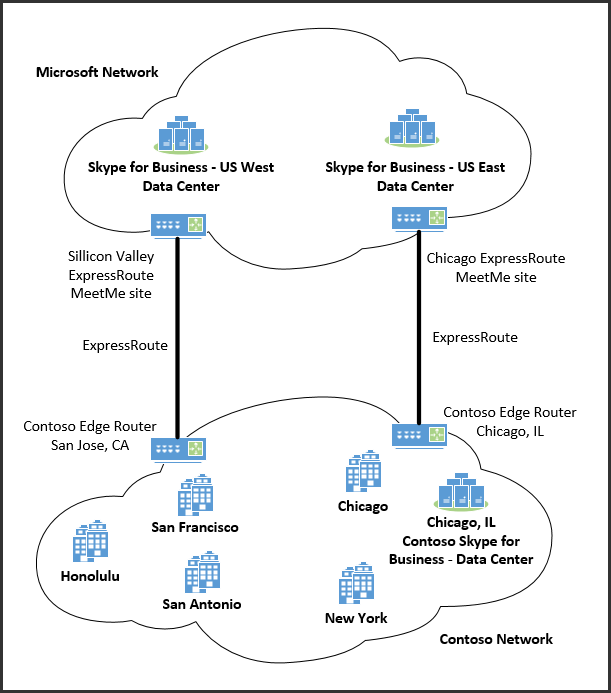
Online deployment with Cloud Connector Edition
Skype for Business Cloud Connector Edition is a hybrid offering that consists of a set of packaged Virtual Machines (VMs) that implement on-premises PSTN connectivity. By deploying a minimal Skype for Business Server topology in a virtualized environment, you will be able to send and receive calls with landlines and mobile phones through the existing on-premises PSTN voice infrastructure.
If you decide to deploy Azure ExpressRoute and Cloud Connector Edition, we recommend for you to set up at least one Express Route connection for each continent between each continent's main site to it's closest ExpressRoute peering location. Depending on cost vs benefit, for each continent you can choose to deploy additional ExpressRoute connections from sites where network performance targets aren't being met.
If you have an on-premises Microsoft Teams deployment, you must follow the Planning Guide for Skype for Business Cloud Connector Edition. Specifically, the Access Edge and A/V Edge services should be assigned public IP addresses and reachable Microsoft 365 or Office 365 data centers.
In the following example, Contoso is a European accounting firm with presence in a few major European countries/regions and cities. When they sign up for Microsoft Teams for all their collaboration needs, they decided to put a Cloud Connector for each country/region they have a physical location to continue to use their PSTN infrastructure and carrier contracts that already exist. Based on their testing from all their sites and Microsoft network Edge, they determined that a single ExpressRoute connection in London will help meet the Microsoft Teams client connection network performance targets described in Network Performance requirements from a Skype for Business client to Microsoft network Edge.
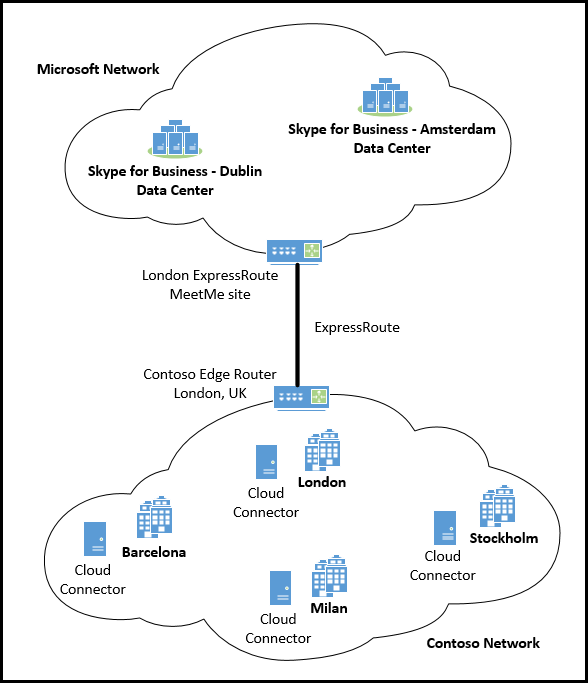
Below is another deployment option for Contoso. In this case, they decided to set up an ExpressRoute connection at each site where a Cloud Connector is deployed.
